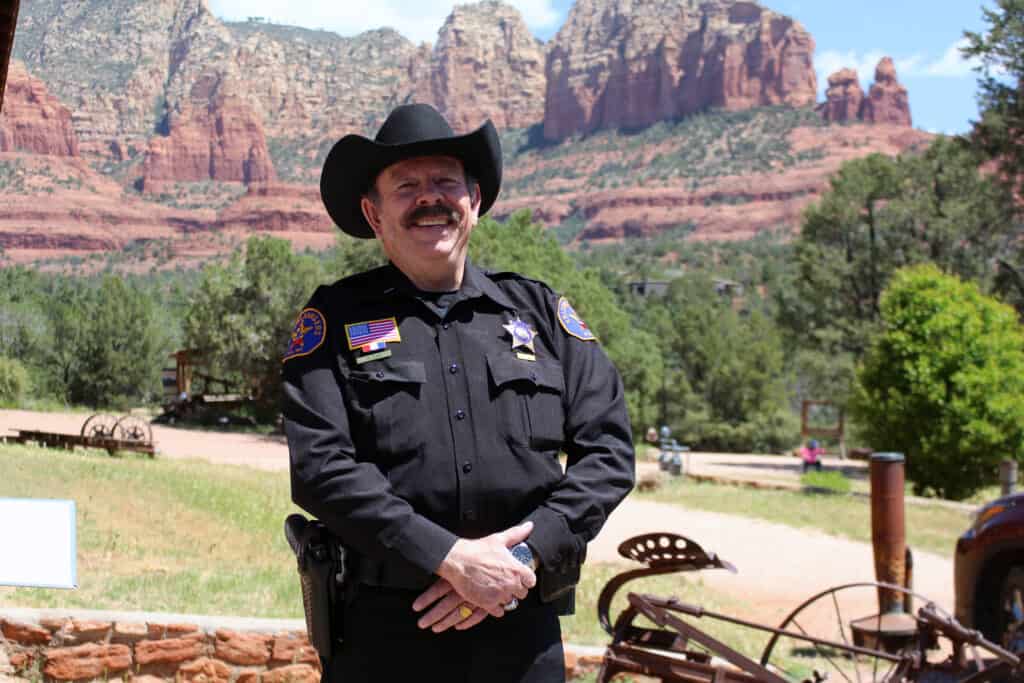The Sedona Historical Society closed out its spring series of Living History presentations on Thursday, May 11, with Arizona Ranger State Historian Nick “Colorado” Cain’s talk “Arizona Rangers: Few but Proud, Then and Now.”
Keeping the Rangers’ legacy alive by helping to oversee the activities of regional Ranger historians has become Cain’s passion. He joined the Rangers in 2015 and became the group’s historian in 2021.
Prior to joining the Rangers, Cain worked as an Army military policeman in Vietnam, a member of the Colorado State Patrol and a municipal police officer in Denver, and closed out his career as a California deputy commissioner for enforcement assigned to the Los Angeles District Attorney’s real estate fraud unit.
“My goal, before my appointment ends, is to have a company historian at each location,” Cain said. “Right now, we only have eight [local historians]out of 23 [sites]. So it falls on the company commander to keep those documents preserved for history.”
The Arizona Rangers were first authorized by legislation on March 21, 1901, to help prepare the Arizona Territory for statehood. The unit was modeled on the Texas Rangers and tasked with curbing property theft.
Over the next eight years, 107 men served in the outfit, which consisted of a captain, a sergeant and 12 privates. The original group made nearly 4,000 arrests, the majority of which involved cattle rustling, and later entered the realm of Western lore and popular culture, being immortalized in song, on the silver screen and on television in the 1950s series “26 Men.”
“There were actually Arizona Rangers back in the 19th century, in the 1860s and the 1880s,” Cain said. “But, because that chapter of history involved a lot of violence … I, as a historian, am discouraged from talking about [it]. The modern day Arizona Rangers trace our lineage back to the 1901-1909 era of rangers. We tend to discount the Rangers that came before them who were involved in what was known at the time as the Apache Wars.”
During the era of the original Ranger company, two Rangers were killed: Carlos Tafolla, also spelled Tafoya, during a 1901 shootout near Show Low in pursuit of the Bill Smith Gang, and Jefferson Kidder in 1908 while raiding Naco, Sonora.
“The rangers were so good at keeping law and order they pretty much put themselves out of a job,” Cain told the audience. “A budget-minded legislature and partisan politics, along with political pressure from other law enforcement groups, caused their termination on [Feb. 15, 1909]. They had pretty much outlived their usefulness.”
A few of the Rangers remained in contact, holding reunions, and were often honored guests in rodeo parades after their disbanding. By the early 1950s, the survivors started talking about putting together a law enforcement-type auxiliary that could augment local paramilitary forces.
“Most of the Rangers reluctantly turned in their much coveted badges at the governor’s request,” Cain wrote in the Rangers’ spring 2022 newsletter. “The rumor being they were all going to be melted down to prevent any ‘ex-Ranger chicanery’ on the open range with the killers of recently murdered Sgt. Kidder still on the loose.”
The modern day rangers were re-established in 1957 by surviving members of the original Arizona Territorial Rangers and were recognized by the state in 2002 when then-Gov. Jane Dee Hull signed Legislative Act 41. Membership is around 500 and is mostly made up of current and former law enforcement personnel organized into 23 companies.
“We actually report to the governor as a law enforcement auxiliary,” Cain said. “We are available to any law enforcement agency that needs to be augmented with boots on the ground. We have
Uptown patrol here in Sedona, because during tourist season, you’ll see 2 million tourists, on average, coming into Sedona. Well, the Sedona Police Department is a small agency. So they readily accepted our offer to come in and conduct foot patrols in the Uptown area and we have a memo of understanding with the chief, which allows us to work under his control.”
Additionally the Rangers are available to escort people to their vehicles after dark in the Uptown area, Cain pointed out. However, it’s important to note that they have no more law enforcement authority than any other resident of Arizona.
Some of the group’s security actions at the state level have been controversial, such as providing more than a dozen uniformed Rangers as security personnel during the 2021 ballot audit at the Veterans Memorial Coliseum in Phoenix, for which the group received over $182,000 from social media fundraisers and from the Arizona Senate.
“The senate will pay $20,000 for the Rangers’ services, with the word ‘compensation’ crossed out and above that, the word ‘contribution’ written in hand,” is how an agreement between
Senate President Karen Fann of Prescott and Mike Droll of the Arizona Rangers reads. The agreement was first disclosed in June 2021 by the Phoenix New Times.
Within Yavapai County, the Granite Mountain Company of the Rangers received a $1,000 donation from the Chino Valley Town Council on April 11 as a sign of appreciation for their working 24-hour shifts for a week to turn back motorists at Perkins Road during the March flooding.

“We’re always looking for civic-minded individuals who want to volunteer for the Arizona Rangers,” Cain said. “There is a screening process, financial commitment [for] equipment. But the job satisfaction is intense. I go to something like this, and if I’ve only opened the eyes of one attendee as to our history, then I’ve done my job. If I can entice one attendee to to volunteer to be an Arizona Ranger, then my day is complete.”



